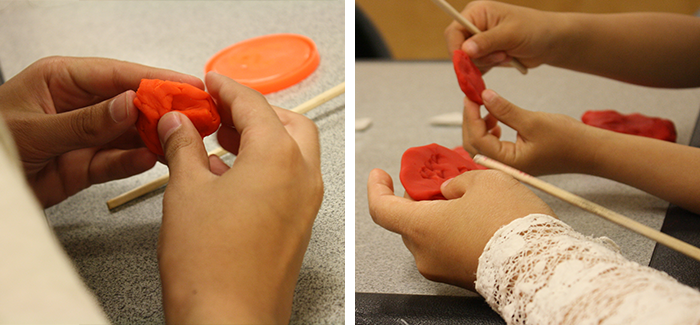
(Photography by Kathryn Vandervalk, ’16)
Elementary school children experience the history of language hands-on at the Oriental Institute.
Moriah Grooms, AB’11, youth and family programs coordinator at the Oriental Institute, asks a small audience of families, “If this picture was a message, or a story, what would it say?”
[[{"type":"media","view_mode":"media_original","fid":"1772","attributes":{"alt":"","class":"media-image","height":"338","typeof":"foaf:Image","width":"460"}}]]
A seven-year-old suggests that the picture shows a man trampling grass instead of walking on the path from the house. Another offers that the smoke means that someone is cooking inside the house, or that the house is on fire. The sun means that it is daytime. The man is walking to the tree. The tree is really big. The children agreed that there is room for interpretation.
During Hands-On History: Little Scribe, a Wednesday morning event at the Oriental Institute, Grooms invites the elementary school students to consider what life would be like if they couldn’t communicate through the written word. Pictographs, like the man who might be walking toward the tree, don’t always convey a clear message. Writing is necessary, Grooms tells the class, for restaurant menus, street signs, and fantasy stories (which one enthusiastic girl claims to write from her bedroom).
Grooms, a Near Eastern languages and civilizations major, helps the children start to build their own system of cuneiform from the bottom up. The students and one volunteer grandfather help Grooms make a chart that shows the process of distilling pictures into language. Grooms instructs them to first draw a picture of each object: a loaf of bread, a foot, and water. It takes some effort, and Grooms drives the point home by asking the young fantasy writer if she could imagine drawing every word when she writes her stories. For the next row in the chart, they can only use five lines to make the same picture. Lastly, they can only use three lines, creating their own cuneiform shorthand. Grooms passes around clay tablets from different time periods in Mesopotamia to show that the Mesopotamian system of writing evolved in a similar way, from pictures to characters.
[[{"type":"media","view_mode":"media_original","fid":"1773","attributes":{"alt":"","class":"media-image","height":"338","typeof":"foaf:Image","width":"460"}}]]
Grooms at the blackboard.
Then the children head into the basement to try their hand at the ancient writing system. Grooms teaches them the ancient Mesopotamian system of numbers, using single digits, bases of ten, and bases of sixty. As they write on Play-Doh tablets with chopsticks, they discover how difficult it is to use clay instead of paper. Kids their age in Mesopotamia had similar complaints, Grooms says. After some experimentation, the children are able to take home their own clay tablets that they inscribed with their birthdays.
